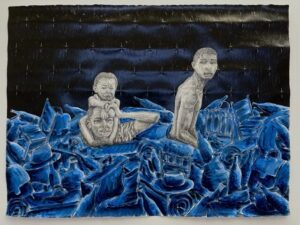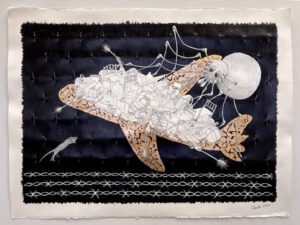Migration and the Webs they Spin: Rodney Zelenka
Nancy Nesvet
Rivers of Babylon at LichtundFire Gallery, 175 Rivington St., New York, opened a show of Rodney Zelenka’s works on paper on June 27-July 28, and open by appt after those dates. Curated by Elga Wimmer and Priska Juschka, the drawings, inspired by Panama’s past political dictatorship in Panama, the migration of his family and heritage as a grandchild of holocaust survivors, he claims the work is about the person depicted and his reality, “about the self-what am I supposed to do?” I would add what am I supposed to be? The work is clearly about migration and the constant moving of migrants from one location to another, the reactions of governments to that relocation, and the webs that government officials spin to ensnare those migrants.
Incorporating gold leaf, aluminum foil, pins, paper, and paint on canvas, he claims to be influenced by Picasso, and I do see the influence of Guernica, but whereas Guernica was covered in bold strokes depicting bulls and people and symbols of Franco’s Spain, Zelenka’s work is airy, the space equal to the marks beneath and surrounded by it. Like Picasso, there are strokes of bright red (and for Zelenka other bright colors) and they are often equal to the black marks and white space, but when I look at the drawings and paintings, it is that indeterminate, unmarked space with no specific heritage or location that seems important. It is about possibility, the possibilities inherent in the future of the travelers he depicts and symbolizes with their suitcases. That upper space is often filled with objects, as in “Webmasters” with images of Putin, Obama, and other governmental figures with objects one would travel with, including hats and suitcases. Those suitcases are all the same, lacking location, ownership, or heritage. They could be anyone’s, yours, mine, the travelers depicted or our ancestors’.

We cannot avoid seeing Goya’s influence, in the black and white drawing and quality of line, as we remember that Zelenka is Panamanian and has noted his influence by Latin American mural painters, Rivera, Siqueros and others who depicted their politics in paint. We see the use of objects as proxies for people, and people’s fates recalling the work of Anselm Kiefer at the Doge’s Palace during the Venice Biennale 2022-23.
In a painting exhibited in an earlier exhibit at Tenri Gallery in New York, government officials stand under a cache of suitcases and jumbled chairs, all the same, as if government is a game of musical chairs, and suitcases relocated from one place to another, one owner to another, referring to global migration and the insanity of it all. Marc Bloch, a panelist at the panel curated by Elga Wimmer at the exhibit at Licht und Fire, saw the images of suitcases and was reminded of prisoners who had to leave their suitcases at the door. I was reminded of those holocaust victims, including Zelenka’s ancestors, who left their suitcases before entering the gas chambers further seeing Zelenka’s drawings of shipping containers, on what appear tracks, so looking like sealed train cars with chairs and boxes and headboards of beds, and hats and water vessels strewn about. The birds that Zelenka uses as a constant must fly to survive, must keep on the move, as they relocate to feeding grounds around the world, carrying their flocks and with them. The spiders weaving their webs eat the male spiders after engaging in reproduction, having no more use for those who might challenge their power, like officials and politicians. And like officials, spiders weave webs to encapsulate their challengers in places and situations and keep them trapped. Those spiders almost smile, enjoying their power. It is a sly smile, a winning smile.
Panelists also noted Zelenska’s work as reflective of surrealism, and considering the Latin-American murals of Rivera, Siqueros and others, surrealism earns a place in Zelenka’s oeuvre.
Surrealism is encountering a present revival, having been the curatorial theme of the 2022 Biennale d’Arte in Venice. Surrealism shows how we are changing, how our world is changing. That is the essence of Rodney Zelenka’s work, how the world’s population is changing, where people live, how people live, producing new families of multi-national and multi-racial children, changing politics and appearances, attitudes and allegiances, and the threats to immigrants and their incarceration in government produced webs, like those of spiders. Zelenka shows the result of immigration and voyages, packing your life and belongings in a nondescript suitcase and watching them stacked to the sky, getting mixed up together, infused in Rodney Zelenka’s history, but also our own. If artmaking is a creative act, to be creative is to create a new society, a different and hopefully better world for oneself and all of us. Visual art, music, people are all fusing together; language is constantly recreating, adding new words, new symbols, new codes to communicate. Zelenka’s language shows that evolution, but also shows the peril of those journeys.

We see in “Golden Wall” (2022) made on paper of gold leaf, ink, acrylic metal pins, hands holding medieval weapons, images of beds, purses, shoes, blankets, chairs, and eyes, drawn on these objects, all seeing eyes, but also a homage to surrealism and the Mexican surrealist muralists. We see in “Silver Worlds” (2023) on paper of aluminum leaf, metal pins, acrylic and ink, opposing worlds, one half sphere emerging from the bottom of the paper, the other half sphere downward facing from the top, with a sphere of faces and chairs and the usual debris depicted by Zelenka but supported by five swordlike-like rods. We see the same sphere, this time whole, in “Circle of Power” hands holding rodlike weapons at five points emerging from the sphere into a black void. This time objects within the sphere have stringed instruments, as well as hats and chairs and ubiquitous eyes. The parched earth surrounding the black void could be the deserts crossed, or the dry earth indicative of droughts in immigrants’ countries causing them to flee. The drawn white boots, with eyes on the path, spikes sticking out of toes, marching on the parched earth in another drawing opposes the four leg-like bones on either side of the path. “Gold Diggers” (2022) of gold leaf, ink, acrylic and metal pins on paper shows the same sphere, the same weapons, the same parched earth letting us know that there are many reasons people immigrate, and many economic classes. Yet, “Living in Luxury” (2022, used architects’ paper, used clothes, newspaper, acrylic, and ink on paper shows two women. I see a mother and daughter, with the mother on her knees buttoning the school uniform her daughter wears, showing that even, living in poverty, the dignity and importance of sending the child to school. A bed is drawn under the globe holding the women, representing their new home, no longer on the migratory voyage, and two blackbirds fly above. The birds, looking like ravens fly above, still threatening their future. The threat is always there, whether rats, or ravens, or water or drought.
Then we see people, in black and white, so their racial identification is indeterminate, the head of one carrying a baby on his shoulders, another torso deep in blue, looking like water, but hiding the beds, and suitcases and belongings of the travelers, the migrants. Like the people, the belongings are inundated by the water, but also travel on the waves. This is the drawing that held me, that affected me, that made me care about these people, so determined and full of hope to reach better shores and a better life for them and their children. Like the child dressed in her school uniform, it is about the future of the children.
What should I make of the yellow birds flying above the chairs and suitcases left behind, “One of those Moments”, (2023, Acrylic and ink). Have the people gone on? What of the image of a plane, wings and tail of parched earth, pastel-colored shapes and beds and weapons, and the spider, head foregrounding a full moon with its eight legs extended, the plane in its grip, with a barbed wire three-tiered fence underlying it all? It is surrealism, but it is Rodney Zelenka surrealism, updated from that of the last century and commenting on and warning us of the political terrors that might come in this century, that immigrants face as they travel and settle in new lands. This is what art must do, make us aware and warn us, and make us care, and Zelenka has clearly made the art that does that. Bravo.
Nancy Nesvet
